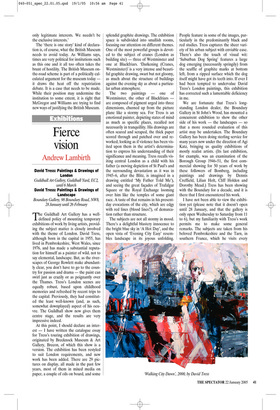Fierce vision
Andrew Lambirth
David Tress: Paintings & Drawings of London Guildhall Art Gallery, Guildhall Yard, EC2, until 6 March David Tress: Paintings & Drawings of Landscape Boundary Gallery, 98 Boundary Road, NW8, 28 January until 26 February
The Guildhall Art Gallery has a welldefined policy of mounting temporary exhibitions of work by living artists, providing the subject matter is closely involved with the theme of London. David Tress, although born in the capital in 1955, has lived in Pembrokeshire, West Wales, since 1976, and has made a substantial reputation for himself as a painter of wild, not to say elemental, landscape. But, as the riverscapes of George Rowlett make abundantly clear, you don’t have to go to the country for passion and drama — the paint can swirl just as crazily or as poignantly over the Thames. Tress’s London scenes are equally robust, based upon childhood memories and refreshed by recent trips to the capital. Previously, they had constituted the least well-known (and, as such, somewhat downplayed) aspect of his oeuvre. The Guildhall show now gives them centre stage, and the results are very impressive indeed.
At this point, I should declare an interest — I have written the catalogue essay for Tress’s touring exhibition of drawings, originated by Brecknock Museum & Art Gallery, Brecon, of which this show is a version. The exhibition has been restyled to suit London requirements, and new work has been added. There are 29 pictures on display, all made in the past few years, most of them in mixed media on paper, a couple of oils on board, and some splendid graphite drawings. The exhibition space is subdivided into smallish rooms, focusing our attention on different themes. One of the most powerful groups is devoted to the subject of cranes (London as building site) — three of Westminster and one at Blackfriars. ‘Darkening (Cranes, Westminster)’ is a very intense and beautiful graphite drawing, swart but not gloomy, as much about the structure of buildings against the evening sky as about a particular urban atmosphere.
The two paintings — one of Westminster, the other of Blackfriars are composed of pigment urged into three dimensions, churned up from the picture plane like a stormy sea. For Tress is an emotional painter, depicting states of mind as much as specific places, recalled not necessarily in tranquillity. His drawings are often seared and scraped, the thick paper scored through and patched over and reworked, looking as if violence has been visited upon them in the artist’s determination to express his understanding of their significance and meaning. Tress recalls visiting central London as a child with his father (a moving depiction of St Paul’s and the surrounding devastation as it was in 1945–6, after the Blitz, is imagined in a drawing entitled ‘My Father Told Me’), and seeing the great façades of Trafalgar Square or the Royal Exchange looming over him like the temples of some giant race. A taste of that remains in his presentday evocations of the city, which are edgy with red lines (blood lines?), of demarcation rather than structure.
The subjects are not all stormy in mood. There’s a delightful blustery innocence to the bright blue sky in ‘A Hot Day’, and the open vista of ‘Evening City Easy’ resembles landscape in its joyous unfolding. People feature in some of the images, particularly in the predominantly black and red studies. Tress captures the sheer variety of his urban subject with enviable ease. There’s also the touch of visual wit: ‘Suburban Dog Spring’ features a large dog emerging (necessarily springily) from the scuffle of graphite marks at bottom left, from a ripped surface which the dog itself might have got its teeth into. If ever I had been tempted to undervalue David Tress’s London paintings, this exhibition has corrected such a lamentable deficiency in me.
We are fortunate that Tress’s longstanding London dealer, the Boundary Gallery in St John’s Wood, has mounted a concurrent exhibition to show the other side of his work — the landscapes — so that a more rounded evaluation of this artist may be undertaken. The Boundary Gallery has been doing sterling service for many years now under the direction of Agi Katz, bringing us quality exhibitions of mostly realist artists. (Its last exhibition, for example, was an examination of the Borough Group 1946–51, the first commercial showing for 50 years of work by these followers of Bomberg, including paintings and drawings by Dennis Creffield, Lilian Holt, Cliff Holden and Dorothy Mead.) Tress has been showing with the Boundary for a decade, and it is there that I first encountered his work.
I have not been able to view the exhibition yet (please note that it doesn’t open until 28 January, and that the gallery is only open Wednesday to Saturday from 11 to 6), but my familiarity with Tress’s work permits me to make some general remarks. The subjects are taken from his beloved Pembrokeshire and the Tarn, in southern France, which he visits every year. His is a fierce vision of landscape, and though there is much beauty to be found, it tends to the unsettling and aweinspiring rather than the reassuring and tame. If Tress risks destroying a painting or drawing with the energy of his attack, the risk is a worthwhile one. These are paintings and drawings as much visceral as visual, made in knowledgeable awareness of the masters of the past (from Cotman, Cox and de Wint to Sutherland and Piper), with an exploratory rigour and glorious verve. David Tress creates a landscape out of himself and, in doing so, renews and strengthens our understanding of the world around us.














































 Previous page
Previous page